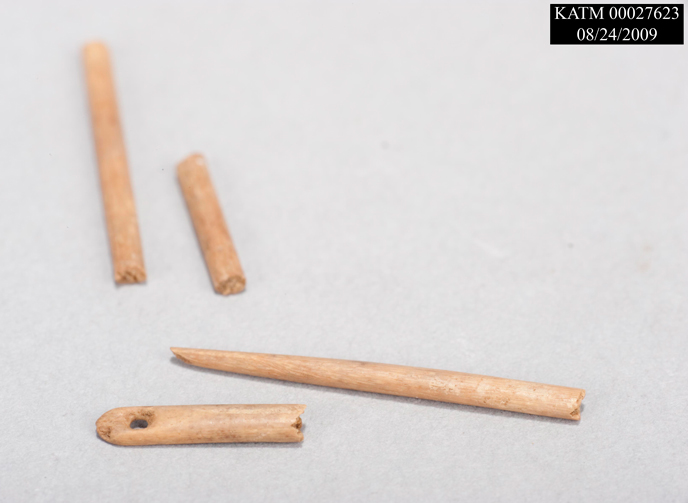
Tools like this are often found in archeological excavations along with the bones and shells of the animals people ate, other broken or lost tools found in the home, or the flakes of stone that were left over from tool making. NPS Photo.
This needle was found along the Pacific coast of Katmai and was made of animal bone between 4,000 and 4,300 years ago—most likely from bone that was left over after a meal. It is strong, durable, and doesn't look significantly different than the needles we use today. Making needles like this took a tremendous amount of skill and time. Using a tool made of stone, splinters of hard long bones were cut out and trimmed to make a rough needle-like shape. They were then meticulously ground and polished so they were the right shape and were very smooth. The delicate eye was made by very carefully drilling into the bone from both sides. The thread they used was probably made of sinew (fibrous tissues that connect muscle to bone), gut, or hair.
Perhaps the person who used this needle made clothing or tents out of animal skins, or a waterproof bag or clothing out of sea mammal intestines. We can only guess at what they made since the products of their labor have not survived. Objects made from hard bone and stone can survive for thousands of years in archeological sites while clothing and other objects made of organic material often do not.

It took care, skill, and precision to make this tool. The scale to the right of the needle pieces measures two centimeters tall. NPS Photo.
The needle raises other questions about the coastal inhabitants of Katmai--who made this needle? A man? Did a woman shape this needle and make it this exact size and shape to use for a certain sewing task? Who used it? A young child just learning to sew? A man fixing a seam on his clothes? A mother making a sleeping bag for her infant child? How did it end up in the archeological site? Was it lost after someone dropped it and broken as a result of trampling? Was it broken and therefore discarded?
Whatever the answers to these questions might be, this needle connects us to those people who lived on that windswept and stormy coast over 4,000 years ago. They, like us today, needed to patch clothes, sew seams, and care for their loved ones by providing them with clothing, shelter, and warmth. They are gone, but this small household object that looks nearly identical to the needles we use thousands of years later remains.
